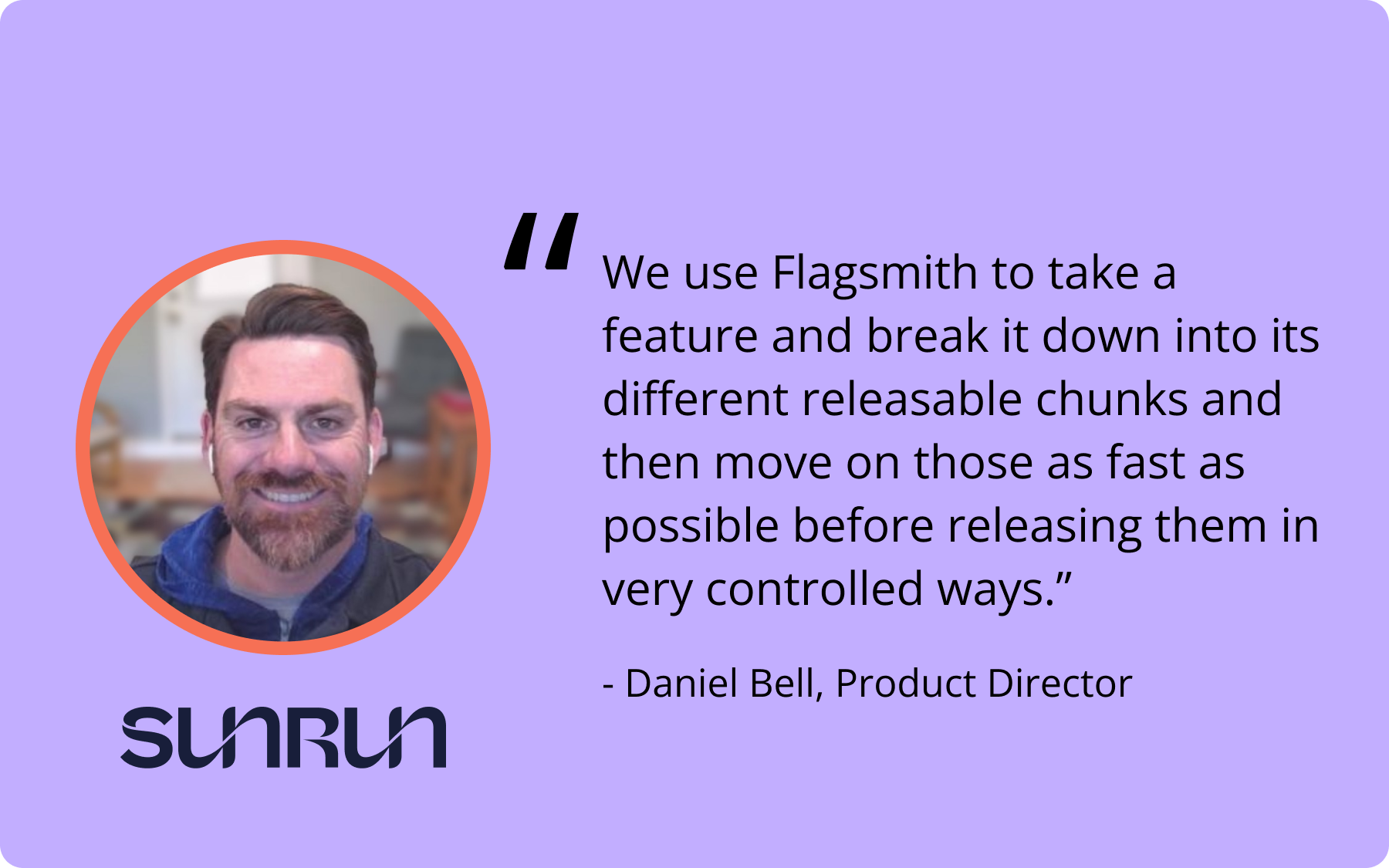
I lead the Software Product Management function for Sunrun's sales platform and software product for the Revenue group. I’m an eighteen-year veteran of the home energy and solar space.
“We're constantly working on developing new features, new capabilities, and new differentiators. We don't want to delay driving value or delay learning. We use Flagsmith to take a feature, product, or project and break it down into its different releasable chunks and then move on those as fast as possible before releasing them in very controlled ways. This allows us to avoid bottlenecks and prioritise speed.”
Sunrun is a leading provider of residential solar energy solutions, helping homeowners transition to renewable energy. With a commitment to clean energy and customer-centric solutions, Sunrun continuously innovates its technology to improve sales, operations, and customer experience.
Daniel and his team support sales representatives by developing applications that dynamically adjust based on customer needs. These applications must be agile, reliable, and scalable, enabling sales reps to present the best possible solar solutions.
Before implementing Flagsmith’s feature flag tool, Sunrun’s software engineers had to manually enable feature pilots, making the effort to expand pilots or to roll them back slower.
Flagsmith has enabled Sunrun to adopt a more iterative, controlled approach to feature development and deployment. The team now uses feature flags for every major release, allowing them to break down projects into smaller, testable phases.
“We take an agile approach, driving value as soon as possible,” Daniel explains. “With Flagsmith, we can release new features in a controlled way, ensuring they work as expected before rolling them out more broadly.”
Granular rollouts: Sunrun can progressively introduce features to specific user groups, such as subject matter experts, before expanding deployment to broader teams.
Validating new features in production: The team can confirm that features function correctly in a real-world environment while maintaining stability.
Enhanced collaboration: Engineers and product managers now work closely together, defining release phases collaboratively and iterating based on real user feedback.
Since adopting Flagsmith, Sunrun has significantly improved its ability to deploy features efficiently and safely. Daniel highlights how the feature flag tool has transformed their release process: “Before Flagsmith, we didn’t have this level of fine-tuned control. We had to be more hesitant about releases. Now, we can go to market in smaller slices, increasing our confidence in the final product.”
Additionally, Flagsmith has helped Sunrun:

“We'll take a feature and develop it as soon as we can. We'll make sure that we QA it, of course, but we try to go as fast as we can and then release it to say, two super users, for example, who are subject matter experts. I’m lucky that my direct customers are also employees at my company. So we can communicate constantly about what’s good as well as what needs to change. Then we tweak it and iterate until we can scale it.
Once we’ve actioned the super users’ feedback, we’ll introduce it to their teams before expanding geographies until eventually we fully roll something out. And by this point, we get to roll something out that we're highly confident in. It’s not a ‘ship it to production and cross your fingers and see if everything explodes’ sort of thing.
Previously, we had to deal with a certain margin of error between our testing and production environments—they’re almost never 100% the same. So by being able to use feature flags, we have an extremely high level of control and can move something to production and validate that it works the same way it’s worked in our staging and testing environments.
And it’s not only that it’s been in production for a long time and is stable. We’ve also already evaluated if it’s meeting the needs of our users and if it’s creating the outcomes we need. And we figured that all out ahead of time by starting early and using Flagsmith’s Segments to roll it out.”
One of the most valuable aspects for Daniel and his team is the ability to revert changes instantly if needed. “If something doesn’t work, we can turn the flag off in seconds instead of going through a full deployment rollback.” This level of control has removed much of the hesitation around launching new features, making the entire process more agile and efficient.
“Flagsmith gives us a level of control that allows engineering and product teams to work together to find the points where we can break down a feature or find a releasable set of features for an overall product.
For example, we're working on a feature set right now, and we've broken it down into three phases. I worked with the engineer responsible to decide what those phases would be and where feature flags could help. We’ve enjoyed an increased level of autonomy in developing features and being able to decide how we want to develop the overall feature set and in what order and in what releases.”
We’re thrilled to see how Flagsmith has enabled Sunrun, and we’re excited to see what they do next!
Check out more customer stories
.webp)